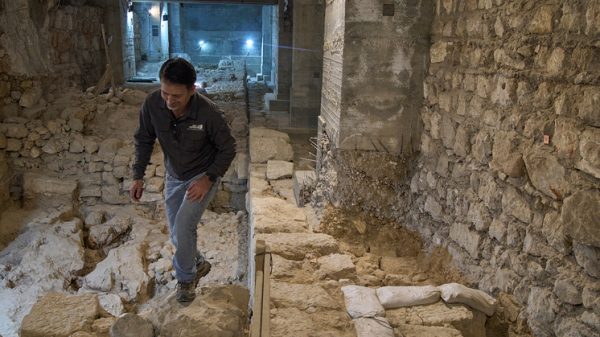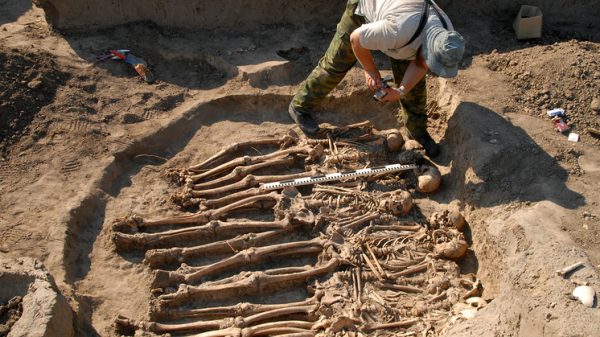Tangible and competitively priced proof of one of the Lord’s more mysterious recent manoeuvres can be found in a church nestled in the foothills of the Sierra de Moncayo in north-eastern Spain.
A familiar face, now known to the world as Monkey Christ, greets visitors to the Santuario de Misericordia, its blurred and startled features staring down from bottles, thimbles, bookmarks, teddy bears, pens, mugs, T-shirts, mousepads, badges, fridge magnets and keyrings.
For centuries, the nearby town of Borja was best known for its wines and splendid 16th-century town hall. All that changed six years ago when a simple act of devotion was transmogrified into an object of ridicule, a meme and, eventually, a tourist attraction.
In the summer of 2012, a devout parishioner, Cecilia Giménez, noticed that an already flaking and faded painting on the church’s wall was under threat from a leak.
Giménez, then 81, decided that if she did not act, the face of Christ that the artist Elías García Martínez had painted almost a century earlier would disappear for ever.
Pained at the idea of its loss – and keen to conserve the interior of the church in which she had been married – Giménez began work, applying thick blocks of colour on which she planned to retrace the divine countenance.
Had she been able to finish the job, things might have turned out differently. But Giménez had to leave town on a trip and her incomplete efforts soon came to the attention of the local historical association, which indignantly posted before-and-after pictures of the painting.
From there, the story and images went viral.
Before long, García Martínez’s work had ceased to be known as Ecce Homo and, as Monkey Christ or Potato Jesus, has become an irresistible visual shorthand for anything tending towards the disastrous.
The townsfolk were up in arms, the media descended and Giménez lost 17kg through stress, worry and the thought that she had made a laughing stock out of Christ’s suffering face.
Then two things happened: the anger in Borja subsided when people found out who had undertaken the restoration. And the tourists began arriving.
“As soon as people knew that it was Cecilia who had done it, everything changed,” says the mayor, Eduardo Arilla. “And this has become a social phenomenon and a pop art icon.”
Between August and December 2012, 45,824 people visited the sanctuary. The numbers may have dropped off since then, but Borja still receives 16,000 visitors a year – more than four times the number who came before Giménez picked up her brushes.
Not only has the picture’s fame provided jobs for the sanctuary-museum’s two caretakers, it also helps fund places at Borja’s care home for the elderly, a haven for those who would not otherwise be able to afford to live there.
Quick guide What is the Upside?
Show
Hide
Ever wondered why you feel so gloomy about the world — even at a time when humanity has never been this healthy and prosperous? Could it be because news is almost always grim, focusing on confrontation, disaster, antagonism and blame?
This series is an antidote, an attempt to show that there is plenty of hope, as our journalists scour the planet looking for pioneers, trailblazers, best practice, unsung heroes, ideas that work, ideas that might and innovations whose time might have come.
Readers can recommend other projects, people and progress that we should report on by contacting us at theupside@theguardian.com
Was this helpful?
Thank you for your feedback.
Arilla is careful not to condone the actions that put Borja on the map – and to point out that there is more to the town than just the Ecce Homo – but he welcomes the interest, the tourists and their euros.
“It was a media phenomenon, but it’s also been a social phenomenon when it comes to helping people,” he says. “If it hadn’t happened, maybe Borja would have become famous for something else, like its wine. But we wouldn’t be as well known as we are now.”
The media phenomenon has not been limited to Borja. In June this year, the overenthusiastic restoration of a 500-year-old statue of St George in a church in Estella, Navarre, elicited comparisons with Tintin, while the treatment meted out to a group of 15th-century wooden statues in Asturias left a professional restorer torn between tears and laughter.
Estella’s mayor, Koldo Leoz, says the town has seen an increase in visitor numbers but adds that it predates the St George incident and is down to a concerted effort to restore the old Jewish quarter and attract pilgrims walking the Camino de Santiago.
Estella, he says, has no plans to capitalise on the botched restoration. “We don’t want to attract visitors because of the poor treatment of our heritage,” he says. “We haven’t publicised it and nor will we.”
Ana Galán Pérez, the chair of Spain’s Professional Association of Restorers and Conservators (Acre), argues that such cases show that the country needs to do more to protect the myriad and often forgotten treasures of its past.
“We seem to be rather indifferent when it comes to the heritage around us,” she says.
“There’s still a long way to go and that’s why we need to educate society and public bodies so that they understand that every time someone without the right qualifications tries to restore a work, they run the risk of damaging or even destroying it.”
Galán and others also dispute the notion that Spain is more prone to dodgy conservation than other countries.
“When we talk to our colleagues from other European countries, they tell us that these things are happening but that they’re not picked up by the press.”
Román Fernández-Baca Casares, director-general of fine arts at Spain’s culture ministry, describes the unfortunate restorations as “isolated cases” and says that almost all the country’s regional governments adhere to strict conservation rules.
Giménez has come to terms with both her actions and the fame they have brought her and her town.
As the mother of two disabled children, she is used to looking past the surface. When she looks at the Ecce Homo today, she sees “a handsome face; a face that I love”.
She also insists that she would do the same thing again. “It was done with good intentions and despite what happened, it’s been a good thing for Borja,” she says. “People from all over the world are visiting the sanctuary now. That’s the best medicine. I used to cry a lot over all this but I don’t cry any more because I can see how much I’m loved.”
But Giménez is aware that things could have ended less happily.
What advice does she have for other amateur restorers? “Don’t do it. It turned out well in the end here, but it doesn’t always end well in Spain — and you’ll find yourself in the papers.”
This article is part of a series on possible solutions to some of the world’s most stubborn problems. What else should we cover? Email us at theupside@theguardian.com






















































Свежие комментарии